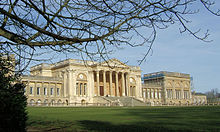Influence on later architecture

This section does not cite any sources. (January 2019) (Learn how and when to remove this template message) |
Roman architecture supplied the basic vocabulary of Pre-Romanesque and Romanesque architecture, and spread across Christian Europe well beyond the old frontiers of the empire, to Ireland and Scandinavia for example. In the East, Byzantine architecture developed new styles of churches, but most other buildings remained very close to Late Roman forms. The same can be said in turn of Islamic architecture, where Roman forms long continued, especially in private buildings such as houses and the Turkish bath, and civil engineering such as fortifications and bridges.
In Europe the Italian Renaissance saw a conscious revival of correct classical styles, initially purely based on Roman examples. Vitruvius was respectfully reinterpreted by a series of architectural writers, and the Tuscan and Composite orders formalized for the first time, to give five rather than three orders. After the flamboyance of Baroque architecture, the Neoclassical architecture of the 18th century revived purer versions of classical style, and for the first time added direct influence from the Greek world.
Numerous local classical styles developed, such as Palladian architecture, Georgian architecture and Regency architecture in the English-speaking world, Federal architecture in the United States, and later Stripped Classicism and PWA Moderne.
Roman influences may be found around us today, in banks, government buildings, great houses, and even small houses, perhaps in the form of a porch with Doric columns and a pediment or in a fireplace or a mosaic shower floor derived from a Roman original, often from Pompeii or Herculaneum. The mighty pillars, domes and arches of Rome echo in the New World too, where in Washington, D.C. stand the Capitol building, the White House, the Lincoln Memorial, and other government buildings. All across the US the seats of regional government were normally built in the grand traditions of Rome, with vast flights of stone steps sweeping up to towering pillared porticoes, with huge domes gilded or decorated inside with the same or similar themes that were popular in Rome.
In Britain, a similar enthusiasm has seen the construction of thousands of neoclassical buildings over the last five centuries, both civic and domestic, and many of the grandest country houses and mansions are purely Classical in style, an obvious example being Buckingham Palace.
Comments
Post a Comment